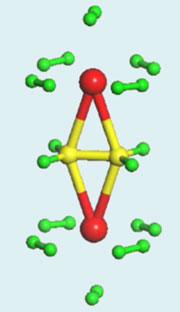博文
科学家发现新的室温储氢材料——Titanium molecules complexed with ethylene
|


Tantalising boost for hydrogen storage


16 November 2007
The quest to find materials which safely store large amounts of hydrogen has received a tantalising boost. US chemists have announced the discovery of a new hydrogen-storage material, which they say stores large amounts of the gas at room temperature. The material is nowhere near practical application, but its theoretical capacity beats oft-quoted US Department of Energy targets for storage materials to power a car several hundred miles on hydrogen fuel.

|
Ten hydrogen molecules (green) surround a capsule-like ethylene molecule (yellow) attached to two titanium atoms (red).
© © Tanir Yildirim, NIST
|
Last year, physicists led by Taner Yildirim working at the US National Institute of Standards & Technology (NIST), Maryland, predicted that transition metal atoms bound to ethylene could bind large numbers of hydrogen molecules.1 As they explained, the interaction between hydrogen molecules and transition metals is just strong enough to allow binding around room temperature.
The key to experimental verification, Shivaram said, was to prevent the titanium-ethylene complexes from clustering together on the support, so that hydrogen molecules could fit between them. This means that for practical hydrogen storage the molecules would have to coat the surfaces of sponge-like supports with high internal surface area, such as zeolites - and that, together with low-purity hydrogen gas streams, could reduce the total weight per cent absorption of the whole system.
Shivaram said that the findings, which are unpublished, met with some scepticism at the symposium. They have not yet been separately validated, as the system is not robust enough to be sent out from the lab. Nor have the researchers done experiments to check whether hydrogen can be released and re-absorbed in cycles, though theoretical predictions suggest this could be possible.
But the inventors are working to patent their discovery, and are hopeful that they will be able to steer through the many pitfalls that could scupper the system. 'In terms of hydrogen absorption, these materials could prove a world record,' said Phillips.
Richard Van Noorden
Enjoy this story? Spread the word using the 'tools' menu on the left
References
1 E Durgun et al, Phys. Rev. Lett., 2006, 97, 226102 (DOI: 10.1103/PhysRevLett.97.226102)
|
科学时报 2007-11-20 作者:王丹红
|
氢是一种能源携带者,燃料电池就是以氢气为燃料将化学能转化为电能的发电装置,它是水的电解反应的反向过程,当氢与氧结合时,其产品就是电力、水 和热量,并不会排放温室气体,因此,氢被当做替代化石燃料的新型绿色能源。但是,如果要让氢经济梦想成真,科学家们必须提高氢气生产和储存的效率。
科学家们希望能够提高氢贮存的效率、降低氢贮存的成本,一种方法便是研究如何提高合金的贮氢量。目前,在室温下,最好的氢吸收合金只能储存相当于 其重量约2%的氢,不能实际用于汽车的能量储存箱。另一种材料能够将氢储存量提高到7%,但这需要高温或低温环境,增加了能耗和成本。
2006年,美国国家标准和技术局的Taner Yildirim博士领导研究小组,通过理论计算发现,钛和一种乙烯小型碳氢化合物能够形成稳定的复合结构,这种复合材料能吸收相当于其重量14%的氢。 在弗吉尼亚大学Bellave Shivaram教授实验室做博士后的亚当·菲利浦决定通过实验来证实这一理论。
菲利浦用一束激光将钛在乙烯气体中蒸发,所形成的复合材料在基底上形成一层薄膜。然后,他在室温下将氢加入到这种合金中,发现合金的重量增加了 14%,与理论计算的结果一样。在成功进行一系列实验后,菲利浦于11月12日召开的会上说:“储存量约为以前材料的2倍,有了这项发明,氢能源社会将变 成现实。”Shivaram指出:“新材料通过了我们尝试进行的所有性能验证实验,相信该材料会给社会带来很大影响。”
通用汽车公司研发中心的氢储存专家Gholam-Abbas Nazri说:“这个新结果令人十分激动。”但他同时强调:“我们必须十分小心。”因为在此之前,这个领域中已经出现了很多错误性的结果。而且,研究人员 还必须做出更大块的材料,并表明这种储氢能力依然存在,同时还必须表明氢的释放能够像氢的储存那样容易。
即使面对这样的警告,美国阿贡实验室的物理学家George Crabtree仍坚持认为,这一结果是最近几年来最有发展潜力的突破。
https://blog.sciencenet.cn/blog-3913-11189.html
上一篇:zhenmafudan解读催化类杂志(转自小木虫)
下一篇:【催化基础知识普及】氢溢流——H-Spillover